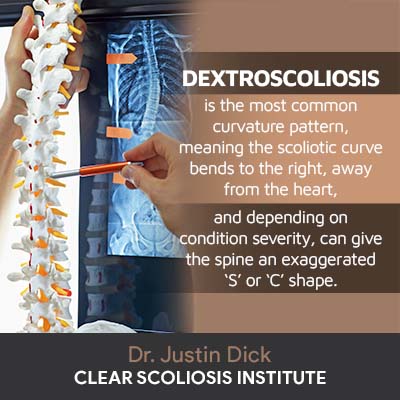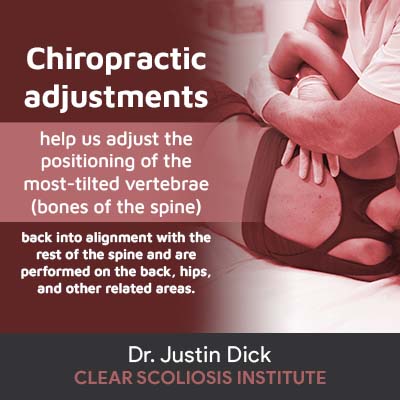
There are many different types of scoliosis, based on causation, and there are also different curvature patterns. Scoliosis can develop anywhere along the spine, although the thoracic spine is the most commonly affected. In most cases, scoliotic curves bend to the right, away from the heart, but in atypical cases with underlying causes, the curve can bend to the left, towards the heart.
Scoliosis is an abnormal sideways spinal curvature, with rotation, and a minimum Cobb angle measurement of 10 degrees. When a scoliotic curve bends to the right, this is the most common curvature pattern and is called dextroscoliosis; when it bends to the left, it’s called levoscoliosis.
Before moving on to the specifics of dextroscoliosis including causes, symptoms, and treatment, let’s start by exploring the parameters that have to be met in order to reach a scoliosis diagnosis.
A healthy spine looks like an ‘S’ when viewed from the side, and appears straight when viewed from the front or back.
The spine is naturally curved because this gives it more strength, flexibility, and facilitates its even distribution of mechanical stress that’s incurred during movement.
If the spine loses one or more of its natural and healthy curves, it disrupts the biomechanics of the entire spine.
While there are numerous spinal conditions a person can develop, scoliosis is one of the most prevalent with almost 7 million people living with it currently in the United States alone.
If the spine develops a scoliotic curve, this means there is an abnormal sideways spinal curve that includes rotation (a twisting element that makes it a 3-dimensional condition), and is of a minimum size.
Curvature size is determined by a measurement known as Cobb angle and is obtained during X-ray; it determines how far out of alignment a scoliotic spine is and places a condition on its severity scale of mild, moderate, or severe.
If the above parameters have been met, a scoliosis diagnosis is given. Part of the diagnostic process is further classifying the condition based on important patient and condition variables such as age, condition type (cause, if known), curvature location, and pattern, which is where dextroscoliosis comes in.
Classifying a condition based on key patient and condition variables is important not only because it streamlines the treatment process, but also because effective and customized treatment plans are designed around these key variables.
In addition to patient age, condition severity, and curvature location, condition type and curvature pattern are also important factors.
Condition type is determined by causation, and in the most prevalent type of scoliosis (idiopathic), causation is unknown. Idiopathic scoliosis accounts for 80 percent of known diagnosed scoliosis cases; the remaining 20 percent consist of condition types with known causes such as neuromuscular, congenital, degenerative, and traumatic.
While idiopathic scoliosis also affects adults, the most prevalent form of scoliosis is adolescent Idiopathic scoliosis (AIS) diagnosed between the ages of 10 and 18.
Idiopathic scoliosis is not associated with a single-known cause and is, instead, considered to be multifactorial: caused by multiple factors.
When it comes to curvature location, scoliosis can develop anywhere along the spine, but it most commonly affects the thoracic spine (middle/upper back), and curvature pattern refers to the direction of the curvature.

Causation is important because as dextrocurvatures are the most prevalent type, characteristic of typical cases of idiopathic scoliosis, when I see a curve bend to the left (levoscoliosis), this is a red flag that the scoliosis is atypical and has an underlying cause (neuromuscular, congenital, degenerative, or traumatic), and the underlying cause will have to drive the treatment approach.
So when it comes to answering the question, what causes dextroscoliosis, the answer is that in the majority of cases, causation is unknown.
Now that we have defined dextroscoliosis and explained how curvature pattern is part of the classification process, let’s move on to addressing common symptoms of the condition.
Symptoms of Dextroscoliosis
As scoliosis is such a highly-variable condition ranging from mild to severe, each case produces its own unique set of symptoms, which is why customizing treatment plans to address important patient/condition characteristics is so important for treatment efficacy.
While there is no one-size-fits-all experience of life with dextroscoliosis, common symptoms involve postural changes that affect the body’s overall symmetry:
The aforementioned symptoms involve postural deviation caused by the uneven forces introduced by the abnormal spinal curve.
As scoliosis is progressive, this means that where a condition is at the time of diagnosis is not indicative of where it will stay. Rates of progression can vary, which is why proactive treatment is so important, particularly in cases of AIS where rapid and unpredictable growth spurts can cause rapid-phase progression.
If a condition has been left untreated, or isn’t treated proactively and progresses in severity, symptoms tend to become more noticeable. In severe cases, scoliosis can start affecting multiple parts and systems within the body:
As a scoliotic curve increases in size, it can start to press on certain organs, causing a variety of potential issues, and when a condition becomes compressive once skeletal maturity has been reached, it can cause varying levels of back pain. When nerves are compressed, radiating pain is commonly felt in the legs and feet.
So now that we have explored what having dextroscoliosis means, how is it treated?
Just as there are different types of scoliosis, there are different approaches to scoliosis treatment. Here at the CLEAR Scoliosis Institute, and in my CLEAR Scoliosis office, patients benefit from a conservative chiropractic-centered approach that prioritizes the spine’s overall health and function.
The traditional approach to scoliosis treatment favors watching and waiting for progression, followed by traditional bracing, and if further progression hasn’t been prevented, patients are commonly funneled towards spinal-fusion surgery.
Here at my CLEAR Scoliosis office, I strive to achieve specific corrective results through integrating multiple scoliosis-specific treatment disciplines for the most effective and customized treatment plans.
CLEAR treatment protocols include three phases and starts with preparing the body for treatment using a variety of therapies to relax the spine and its surrounding muscles: making the body more responsive.
The next phase involves scoliosis-specific chiropractic adjustments that are far more complex and precise than general chiropractic care; these feature the use of advanced mechanical-adjusting instruments designed to achieve gentle and precise corrective results.

The third phase involves a variety of custom-prescribed scoliosis-specific exercises (SSEs) designed to influence balance, coordination, and posture.
The SSEs target specific muscle groups that help provide the spine with optimal support and stabilization, and they also activate certain areas of the brain to improve brain-body communication and achieve a more balanced and natural body position.
By combining different scoliosis-specific treatment disciplines, my team of CLEAR-certified scoliosis chiropractors work towards achieving curvature reductions on a structural level, spinal stabilization, and increasing core strength so the spine’s surrounding muscles can provide it with optimal support.
Dextroscoliosis is an abnormal sideways curvature of the spine that includes rotation, has a minimum Cobb angle of 10 degrees, and bends to the right.
While every case is different and will produce its own unique set of symptoms, common dextroscoliosis symptoms include postural deviation that disrupts the body’s overall symmetry, and in adults, pain is a common symptom; for adolescents who have not yet reached skeletal maturity, the condition hasn’t become compressive and isn’t commonly painful.
As the majority of dextroscoliosis cases are idiopathic, this means it is not associated with a single-known cause.
When it comes to treatment, a conservative chiropractic-centered approach delivered by a CLEAR-certified scoliosis chiropractor can help achieve corrective results without the need for invasive surgery.
If you, or someone you care about, has been recently diagnosed with dextroscoliosis, please feel free to reach out to me directly, or reach out to the CLEAR Scoliosis Institute for additional information and guidance.
Clear-institute.org - Cobb Angle
Clear-institute.org - The CLEAR Approach
Clear-institite.org - CLEAR-Certified Scoliosis Chiropractors

CLEAR provides a unique and innovative way of understanding scoliosis. Sign up to receive facts and information you won’t find anywhere else.

Dr. Dick — I can across your website while searching for information regarding dextroscoliosis and levoscoliosis (terms used in recent diagnostic reports). When I was approx. 13 YOA, I underwent spine surgery for “S” curve scoliosis with Herrington rod fusion/implant. I am now 60+ YOA and have been experiencing significant pain, along with chronic fatigue, low stamina/lack of energy and overall body weakness — and my condition seems to be getting progressively worse. Also have ongoing issues with balance/stance, loss of breath, and digestion.
Although I live in Jacksonville, Florida, I felt compelled to reach out to you after reading your bio. My contact information is provided if you have any advice.